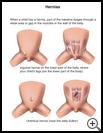
Hernia
________________________________________________________________________
KEY POINTS
- A hernia is when a small part of the intestine bulges through a gap in the muscles of your child’s belly.
- Two common kinds of hernias in children are umbilical and groin or inguinal hernias.
- Most umbilical hernias close without surgery, but groin hernias often need surgery to close the gap in your child’s belly.
________________________________________________________________________
What is a hernia?
When a child has a hernia, part of the intestine (bowel) bulges through a weak area or gap in the muscles in the wall of the belly.
Two kinds of hernias are common in children:
- A hernia in the belly button is called an umbilical hernia.
- A hernia in the lower part of the belly, where your child’s legs join the lower part of the body, is called a groin or inguinal hernia.
What is the cause?
Some children are born with a weakness in the belly muscles. In some babies, some of the muscles in the belly don’t completely come together before birth. This leaves a small opening under the skin.
What are the symptoms?
Symptoms may include:
- Pain or discomfort in the lower belly or groin, especially with physical activity
- A lump or bulge in your child’s belly that may get bigger when your child cries, coughs, or strains
If your child has a lump in the groin that cannot be pushed back, it can mean that part of the intestines is trapped in the gap between the muscles. If blood cannot get to that part of your child’s intestines, part of the intestines may die. This can make your child very sick. Your child will need medical care right away.
How is it diagnosed?
Your child’s healthcare provider will ask about your child’s symptoms and medical history and examine your child. Tests may not be needed, but may include:
- Blood tests
- X-rays
- CT scan, which uses X-rays and a computer to show detailed pictures of the organs inside the belly
- An ultrasound, which uses sound waves to show pictures of the organs inside the lower belly
How is it treated?
Most umbilical hernias close on their own before your baby’s first birthday. Your child may need surgery if:
- The hernia doesn’t go away on its own before your child is 4 to 6 years old.
- The hernia is very large.
- The intestine cannot be pushed back into the belly.
Surgery to repair the opening in the muscle wall is the main treatment for a groin hernia. Your healthcare provider will close the weak spot during surgery. Ask your provider when it’s best for your child to have surgery.
How can I take care of my child?
Follow the full course of treatment prescribed by your child’s healthcare provider. Ask your provider:
- How and when you will get your child’s test results
- How long it will take your child to recover
- If there are activities your child should avoid
- How to take care of your child at home
- What symptoms or problems you should watch for and what to do if your child has them
Make sure you know when you should bring your child back for a checkup. Keep all appointments for provider visits or tests.
Last modified: 2021-01-25
Last reviewed: 2018-10-19

